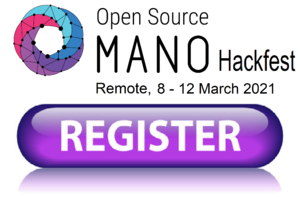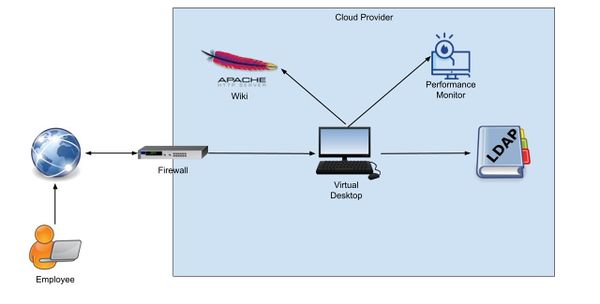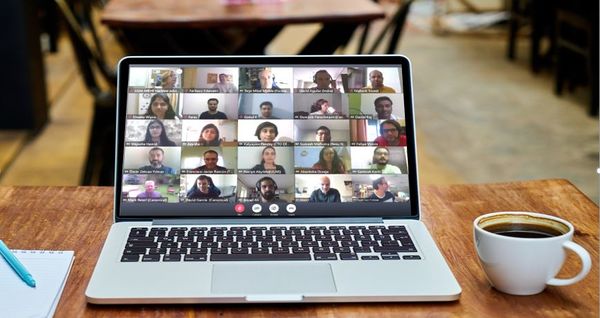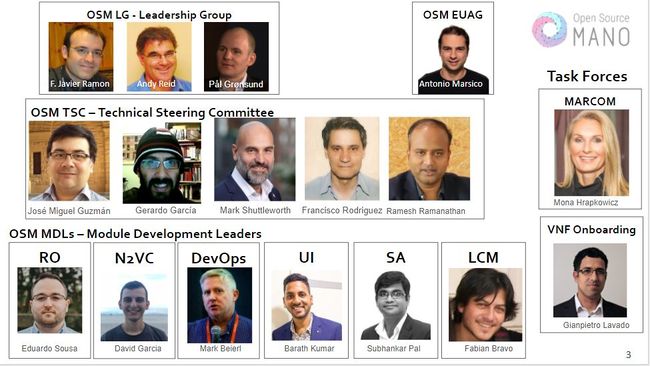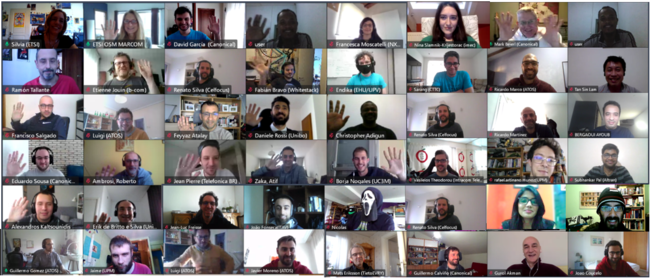OSM-MR10 Hackfest
Overview
ETSI's Centre for Testing and Interoperability and the OSM community are organizing a new OSM Hackfest on 8-12 March 2021. The event will be run remotely, allowing participants to join the hands-on sessions from home.
Participation to OSM Hackfests is free and open to all upon Registration
Registration deadline is Thursday March 4th
Scope
The OSM-MR#10 Hackfest, the very first one featuring OSM Release NINE brings a brand new challenge to OSM users and developers:
- You (or your team) will become a telco operator and will have one week to build your network as a service offering for small businesses.
- You will be provided a complete telco cloud environment with a Kubernetes Cluster and an OpenStack NFVI&VIM.
- You will need to deploy several services to complete your offering for small businesses:
- A Firewall, to keep their data safe
- An LDAP server, to centralize their user management
- A Wiki Server, for their internal documentation
- A Virtual PC for each employee, as they won't have the budget for purchasing laptops
- A centralized Service Monitoring, to make sure they know if there are performance issues
- A Web Proxy, so you they can block certain sites, and optimize internet usage
- In order for the company to succeed, you need to be able to create and manage all these services, and what better way to do that, than automating the whole with ETSI OSM: an end to end management and orchestration solution?
Through this challenge, participants will learn and exchange about:
- How to operate OSM
- Discovering and experimenting with latest features in OSM Release NINE
- Modeling, packaging and on-boarding VNFs, PNFs, CNFs, Network Services, and Slices with ETSI NFV standardized descriptors.
- Developing OSM Primitives for automating Day 1-2 operations
- Troubleshooting, debugging and modifying code in OSM Modules
- ... and so much more!
In addition, participants will hear from key players in the OSM Ecosystem, who will share how OSM is helping them to achieve their goals and latest deployments during the OSM-MR#10 Ecosystem Day
Who should attend
- VNF vendors, who want to onboard their VNF in OSM following best practices
- System Integrators, who want to develop their expertise with OSM
- Service Providers, who want to get first hand operational experience with OSM
- Students and Researchers, who are using or considering OSM as platform for their research activities in networking
- OSM users and developers willing to share, learn and test with the community
Prerequisites
- Registration is mandatory!
- Participants are expected to be familiar with NFV and SDN concepts and have user-level knowledge of Linux, OpenStack and Kubernetes
- You will need your laptop and good internet access
- A remote environment will be made available through VPN for participants to run the hands-on sessions
- If you prefer to install OSM in your own laptop and orchestrate your own cloud, please follow the OSM Quick Start Guide
- Before the hackfest you can get familiar with OSM by watching this video or reviewing previous hackfests' material
Agenda
OSM Hackfest Sessions
Monday March 8th
- 11:00 - 11:10 CET Welcome & Logistics Silvia Almagia, ETSI
- 11:10 - 12:00 CET Hackfest Scenario Overview by Mark Beierl, Canonical
- 12:00 - 13:00 CET Preparing our environment by Mark Beierl, Canonical
- 14:00 - 14:45 CET Network Functions and Services Modeling by Gerardo Garcia, Telefonica
- 14:45 - 15:30 CET NFV SOL006 Adoption and descriptor translation by Alejandro Garcia, Whitestack
- 15:30 - 16:00 CET Checking our environment by Mark Beierl, Canonical
- 16:30 - 17:30 CET Intro to OSM Primitives by David Garcia, Canonical
- 17:30 - 18:30 CET OSM Primitives for PNFs by Mark Beierl, Canonical
Tuesday March 9th
- 11:00 - 12:00 CET OSM Primitives for VNFs by Mark Beierl, Canonical
- 12:00 - 13:00 CET Network Automation (Scaling) by Subhankar Pal, Altran
- 14:00 - 15:00 CET K8s support in OSM by Gerardo Garcia, Telefonica
- 15:00 - 16:00 CET Orchestrating a CNF with Helm Charts by Gerardo Garcia, Telefonica
- 16:30 - 17:30 CET Orchestrating a CNF with Juju Bundles by David Garcia, Canonical
- 17:30 - 18:30 CET Intro to Juju Relations by David Garcia, Canonical
Wednesday March 10th
- 11:00 - 11:30 CET Enabling High Performance in VNFs by Mark Beierl, Canonical
- 11:30 - 12:00 CET Placement Optimization by Lars-Goran Magnusson, Arctos Labs
- 12:00 - 13:00 CET Network Slicing by Fernando Diaz, Atos
- 13:00 - 13:30 CET Playing with our Network Slice by Mark Beierl, Canonical
- 14:30 - 18:00 CET Ecosystem Day (See details below)
Thursday March 11th
- 11:00 - 11:30 CET OSM Development Intro by Mark Beierl, Canonical
- 11:30 - 12:30 CET Workflow Overview & CI/CD Pipeline by Mark Beierl, Canonical
- 12:30 - 13:00 CET Writing Good Tests by Mark Beierl, Canonical
- 14:00 - 15:00 CET Modifying OSM Code by Eduardo Sousa, Canonical and Fabian Bravo, Whitestack
- 15:00 - 16:00 CET Debugging & Running OSM Code (I) by Eduardo Sousa, Canonical
- 16:30 - 17:00 CET Ask Me Anything with OSM TSC & MDLs
- 17:00 - 18:30 CET Debugging & Running OSM Code (II) by Fabian Bravo, Whitestack
Friday March 12th
- 11:00 - 13:00 CET Building Operators from the ground up by David Garcia, Canonical
- 13:00 - 13:30 CET Engaging with OSM by Silvia Almagia, ETSI
OSM Ecosystem Day
Wednesday March 10th Afternoon (2:30pm - 6:00 pm CET)
To attend to the OSM-MR#10 Ecosystem day please kindly register here
- 2:30 - 2:35 Welcome to the OSM-MR#10 Ecosystem Day by Mona Hrapkowicz, Flextronics & OSM MARCOM Lead
The OSM Ecosystem Day allows organizations in the OSM Ecosystem to share about how OSM is helping them to achieve their goals. Presentations and demos cover a wide range of aspects from research activities in academia to production deployments and commercial initiatives, many of them focused in 5G use cases.
- 2:35 - 3:00 On the use of OSM to allow for automated network slice scaling in multi-site environments by Jose Ordonez-Lucena, Technology Innovation and Ecosystem, Telefonica I+D
ETSI ZSM ISG PoC#2 aims at the demonstrating the capacity to automatically scale out a network slice instance deployed across multiple administrative domains. This is achieved using the 5G assets of 5G-VINNI. 5G-VINNI is a large-scale, end-to-end 5G facility composed of several interworking sites, each corresponding to a different EU node and defining a single administrative domain. The management and orchestration capabilities of individual 5G-VINNI facility sites, and the enablers allowing for the interworking across them, are aligned with ZSM architectural design principles. This presentation provides an overview of ZSM ISG PoC#2, showing how OSM stack provides automation means for a zero-touch scaling operation over a multi-site network slice.
- 3:00 - 3:30 Demo: Model-driven Audit Trail Logs infrastructure for Telco VNFs by Wajeeha Hamid, Product Manager OSM, Maciej Mazur, Product Manager Telco, Canonical
Graylog is one of the most popular tools for opensource monitoring and log management in telco environments. We will show how Charmed OSM with the help of juju eases its deployment and integration with MongoDB, elastic search, and other charmed telco network function elements. The same goes for a basic LMA stack with Prometheus and Grafana.
- 3:30 - 4:00 Realization of a public safety vertical use case based on OSM and aerial/vehicular NFV infrastructures by Borja Nogales, PhD Student at Universidad Carlos III de Madrid and Miguel Silva, Researcher at Instituto de Telecomunicações Aveiro
5G communications have become an enabler for the creation of new and more complex networking scenarios, bringing together different vertical ecosystems. Such behavior has been fostered by the Network Function Virtualization (NFV) concept, where the orchestration and virtualization capabilities allow the possibility of dynamically supplying network resources according to vertical needs. In this presentation, we will first describe an NFV-based framework capable of supporting the flexible, cost-effective deployment of vertical services, through the integration of two NFV infrastructures: an infrastructure of Small sized Unmanned Aerial Vehicles(SUAVs), which can be deployed on demand, and an automotive infrastructure, supporting the opportunistic provision of services. To showcase the potential benefits of the proposed framework, the presentation describes an illustrative vertical use case that can be realized on top of it. The use case considers a municipal authority that deploys a service on aerial and vehicular NFV infrastructures to monitor traffic conditions. In case that an emergency situation is detected(e.g., a vehicle collision), the municipal authority uses the MANO stack to instantiate an additional service aimed at assisting emergency operations in this new scenario.
- 4:00 - 4:30 Group Picture & Coffee Break
- 4:30 - 5:00 Commercial VAS domain deployment over RHOSP NFVI governed by Open Source MANO by Dr. Gürol Akman, CTO, Telenity
Telenity will present its journey and experience about the EMEA region’s first complete NFV based VAS domain deployment comprising multiple messaging and VAS solutions as part of Telenity’s VAS Consolidation Platform, deployed on Release 13 of the RedHat OpenStack NFVI and governed by Release EIGHT of the ETSI Open Source NFV Management and Orchestration (Open Source MANO) stack. With this deployment, Telenity swapped12 different VAS offerings from 6 different vendors, migrating them to NS/VNFs consolidated across a geo-redundant architecture. All components of the solution (NFVI/VIM, VNFM/NFVO, NS/VNFs) have been delivered, integrated and launched by Telenity as a turnkey project. The deployed NFV framework also permits the mobile operator to onboard third-party VAS NS/VNFs.
- 5:00 - 5:30 Demo: Vertical's intent evolution at service runtime driving vCDN automated scaling by Francesca Moscatelli, R&D Project Manager & NFV/SDN Architect, Nextworks
5G networks include several heterogenous devices and technologies with an increasing complexity of network infrastructures and services that is affecting Service Providers’ management tasks. Orchestration, automation, analytics and AI/ML techniques are becoming important assets towards the implementation of automated network and service management procedures. At the same time, future networks will be intent-based, with the purpose of hiding such complexity and enabling network and service adaptation depending on a business logic. The proposed demo shows the automated scaling of a virtual Content Delivery Network performed upon the runtime evolution of the service’s intent. In the demonstration the Vertical Slicer prototype, developed by Nextworks, has been integrated with ETSI Open Source MANO as NFV Orchestrator. Following the ETSI ENI approach, multi-layer data collected at virtual infrastructure and application feed a Cognitive Network Management system that recognizes changes in the service’ intents and takes optimization decisions for data-driven closed-loop automations.
- 5:30 - 5:55 TeraFlow in the OSM ecosystem by Dr. Ricardo Martínez, Senior Researcher, CTTC
This presentation tackles the adoption and integration of the OSM within the Teraflow project solution. In a nutshell, Teraflow projects aims at designing and deploying an advanced SDN operating system supporting automated and zero touch service management of heterogeneous transport technologies (IP and Optical). Such an SDN OS will be based on a cloud native architecture handling tera of flows (IoT) and appealing features for multi-domain, multi-vendor, multi-tenancy, and AI-based cybersecurity solutions.
- 5:55 - 6:00 OSM-MR#10 Ecosystem Day Wrap-up by Mona Hrapkowicz, Flextronics & OSM MARCOM Lead
Hackfest Material
Previous Hackfests
- OSM#10 Hackfest - Remote - December 2020
- OSM-MR#9 Hackfest - Remote - September 2020
- OSM#9 Hackfest - Remote - June 2020
- OSM-MR#8 Hackfest - Remote - March 2020
- 8th OSM Hackfest - Lucca (Italy) - November 2019
- 7th OSM Hackfest - Patras (Greece) - September 2019
- 6th OSM Hackfest - Santa Clara (CA, USA) - May 2019
- 5th OSM Hackfest - Barcelona (Spain) - February 2019
- 4th OSM Hackfest - Palo Alto (CA, USA) - October 2018
- 3rd OSM Hackfest - Oslo (Norway) - June 2018
- 2nd OSM Hackfest - Madrid (Spain) - March 2018
- 1st OSM Hackfest - Sophia Antipolis (France) - January 2018
Get involved in OpenSourceMANO
- Join the OSM Community Slack Workspace
- If your organisation is already an OSM member, you can also:
- Request an EOL account (if you don’t have one yet)
- Subscribe OSM general and OSM TECH mailing lists
- If your organisation is not yet an OSM member:
- Learn how to join, it is free and open to all
- Join the OSM Ecosystem
Contact
Please send your technical questions to OSM_TECH@list.etsi.org or join the OSM Community Slack Workspace
Questions about ETSI, joining OSM, this hackfest and future events can be sent to: OSMSupport@etsi.org

